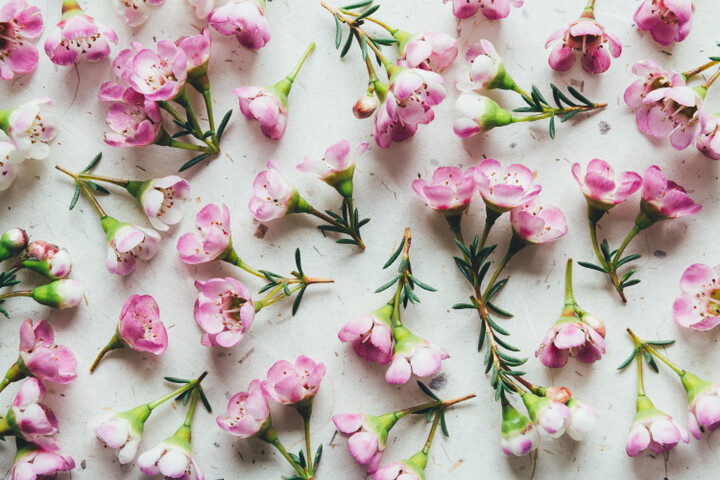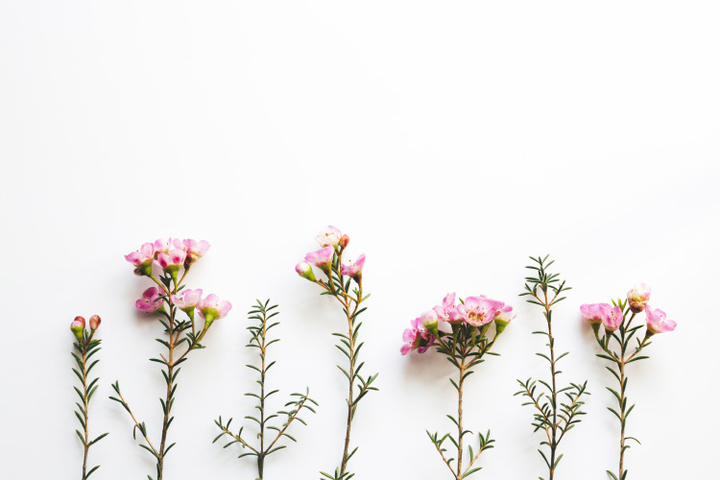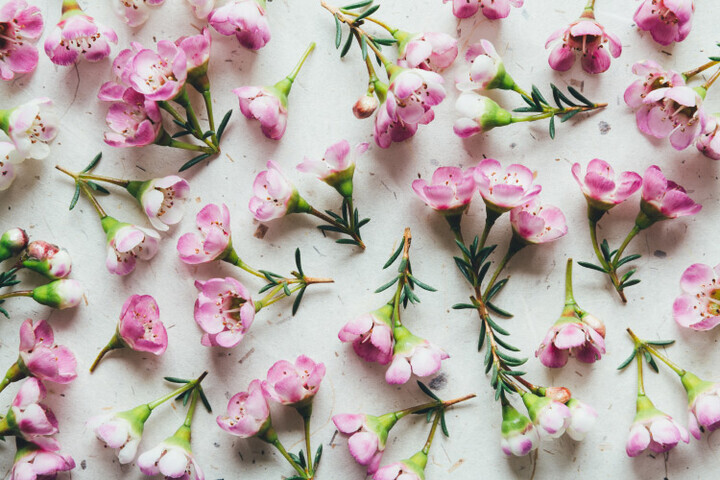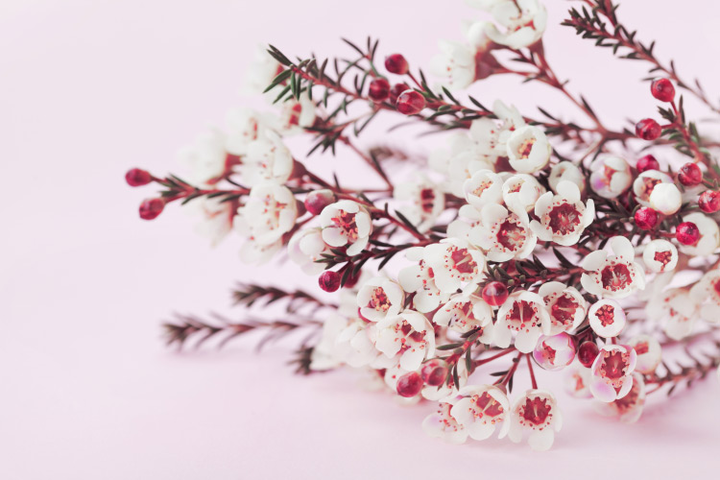
Wax Flowers, common botanical name ‘hamelaucium’, is a genus of shrubs native to Western Australia.
Their blooms are similar to those found on tea trees and due to their look and sweet fragrance, they make the perfect addition to gardens, homes and bouquets.
The most celebrated specie of Wax Flower is the Geraldton Wax (botanical name ‘Chamelaucium Uncinatum’), which is widely cultivated for its large eye-catching blooms. Species from this genus come in the shape of woody evergreen shrubs, which range in size from 15 cm to an impressive three metres in height.
The leaves, which contain oil glands, are small to medium in size and boast a beautiful perfume when crushed. The flowers on this particular genus are delicate in style, brandishing just five petals, ten stamens and a small, hardened fruit.

Origins of the Wax Flower
René Louiche Desfontaines, a French botanist, first discovered this specie of plant in 1819, however, to this day, the source of the name remains unclear.
They are now more commonly known as wax plants or Wax Flowers, due to the slight waxy feel of the petals. Fourteen species are currently acknowledged within the genus.
Closely related genera are together known as the Chamelaucium alliance and include Verticordia, Micromyrtus, Calytrix, Darwinia, Baeckea and Thyptomene.
Cultivation and habitat
Limited to the southwest of Western Australia, Chamelaucium species are most commonly found in heathland communities, where they’re able to grow both inland and on sand, near the coast. Certain genus can also be found in granite outcrops and semi arid climates.
Wax Flowers prefer dryer climates, with sunny spells and good drainage. They are extremely hardy plants and are able to withstand both frost and drought. The most celebrated and widely cultivated genus is C. Uncinatum, which is commonly grown in gardens across southern Australia.
Basic Care – Wax Flowers
Wax Flower plants come from the Myrtle family and bloom (unlike many floral species) in late winter to early spring.
Asides from being a popular option for the garden, these particular blooms are huge in the cut flower industry, as they’re able to last for an impressive three weeks. When growing them in the garden, you can quite simply plant them and forget about them, which makes them a great option for those with a busy schedule.
All that is required is a little light pruning, a small amount of plant food every now and again, and water when they look particularly dry, or when the temperatures outside are extremely high. This plant suffers from minimal pest and disease issues, which again makes them a great choice for those looking for a low-maintenance, yet eye-catching plant

Growing Wax Flowers – What to expect
The Chamelaucium Wax Flower comes in the shape of a quick-growing, thick shrub, measuring between four and six feet in height. Flowers boasts a deep purple to a deeper red hue, with accents of bright, shiny, berry-like buds. These are positioned in open sprays, which sit along the stems. The plant’s foliage offers a deep green shade, and is almost needle-like in style. The stems of this plant have an attractive red hue and flowers often grow to an impressive half an inch in diameter and, once in bloom, typically last for weeks.
Although the traditional plant blooms in winter, there are now several hybrids in existence, many of which boast different bloom periods, as well as different hues, including red, pink and white, which often feature on the same plant.
Growing conditions
Wax Flowers enjoy well-drained soil with plenty of organic matter. If growing younger plants, you will need to place them in protective surrounding to begin with, however more mature plants are able to withstand lengthy periods of drought. One thing to keep in mind if growing in such conditions is the flower production.
This may be slightly less than usual, yet despite this, the plant will still amaze with its rich red stems and eye-catching leaves. For best results, when growing this plant at home, try to mimic the Chamelaucium’s original growing conditions and opt for soil that is both sandy and moisture sparse.
To encourage health and a full set of blooms, choose locations with full sun and prune the Wax Flowers on an annual basis.
Use of Wax Flowers in bouquets
The Wax Flower is a great accent flower, yet is still able to stand proud alone.
The delicate petals and subtle, lemony fresh scent make these long lasting blooms hugely popular in both the home and in floral displays. They’re symbolic of patience and lasting love, which makes them a popular option for wedding bouquets and accessories, including flower crowns.
Wax floral crowns
Floral crowns are a great choice for both weddings and festivals, particularly with those who are wishing to achieve a boho look and feel. Wax Flowers are also more affordable, making them perfect for those who are on a budget. Their simple style makes them suitable for almost any wedding, as they won’t overpower your existing décor.
Wedding bouquets
If you’re looking for a pretty, delicate flower to bulk up an existing wedding bouquet, the Wax Flower is an ideal option and one that will add dimension to the spray. Wax flowers come in a range of different colours, including white, lavender, pink and yellow, meaning there is a hue to suit all.
Simple centrepieces
Wax Flowers are both durable and flexible; in fact, they’re extremely easy to work with. Combine Wax Flowers with a range of other smaller blooms to create a simple, yet effective centrepiece. Many choose to team the Wax Flower with tulips, as they’re also easy to arrange. If you’re planning a rustic, festival-themed wedding, using the Wax Flower alone will create a picturesque effect. As well as using these flowers in bouquets, headpieces and centrepieces, you can add them to the guest’s tables by standing them in mason jars, or alternatively, in an array of eclectic antique vases.

Other uses for Wax Flowers
Wax Flowers have plenty of uses, including in corsages, as cake embellishments, tucked into guest’s napkins at a reception or dinner party and quite simply, left as a sprig on a dressing table – these blooms will provide a fresh palate cleansing smell, which will leave you feeling uplifted and energetic.